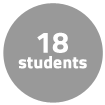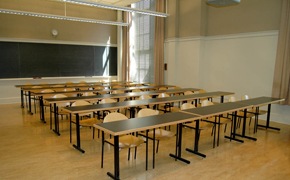Course Overview
This page focuses on the course 18.S996 Category Theory for Scientists as it was taught by Dr. David Spivak in Spring 2013.
This course demonstrated how category theory can be a powerful language for understanding and formalizing common scientific models. The course employed a mathematical tool called an olog (or ontology log), a concept the instructor developed to provide an abstract means for categorizing the general properties of a system. Ologs provide a rigorous mathematical framework for knowledge representation, for the construction of scientific models, and for data storage using linguistic and graphical tools.
During the semester, the power of the tool was tested by its ability to cast taken-for-granted ideas in new light, either by exposing existing weaknesses or flaws in the instructor's and students' understanding, or by highlighting hidden commonalities across scientific fields. In this regard, the course has application for scientists in every discipline.
Course Outcomes
Category theory is especially important in algebra, topology, and algebraic geometry, where it is generally covered in courses in these subject areas, typically at the graduate level. But category theory is rarely taught on its own, at least in the US.
For students, the goal of this course was to get an idea of what category theory is, to improve their ability to see broad patterns in human reasoning, to see how category theory relates to modeling in the sciences, and to gain clarity into their own subjects in the process.
Keep everything as grounded as possible; use fully-worked examples.
—Dr. David Spivak
Below, Dr. David Spivak shares some advice for others teaching a similar course.
Keep Abstract Material Grounded
Keep everything as grounded as possible; use fully-worked examples. As an analogy, if this were a calculus class, we would not have discussed Riemann sums without considering an actual function (e.g., y=x2), step size (e.g., h=0.5), interval (e.g., [1,4]), and computation of total area. The material in this course is sufficiently abstract and new to the students that they need to see it touch the ground. I also used databases (as discussed extensively in the book) to ground the material.
Provide Good Feedback on Homework
Make sure you have a good grader. The students will learn nothing if they do not do the homework, and feedback is essential.
Using Tools
Some students loved ologs, while others thought they were a bit lame. The point of ologs is to teach people to think about functions in everyday life. Some students found operads to be most interesting and wished we could have covered them earlier. This is certainly possible, at least as motivation.
Curriculum Information
Prerequisites
None
Requirements Satisfied
H-Level grad credit
Offered
This was a mathematics topic course. Topic courses like this one allow students a class setting in which to study an advanced topic that is not covered in any other course in the mathematics department. Offerings are initiated by members of the mathematics faculty on an ad hoc basis.

Breakdown by Year
About 1/3 undergraduate students, 2/3 graduate students
Breakdown by Major
About 1/3 math majors, 2/3 students from other science and engineering disciplines.
During an average week, students were expected to spend 12 hours on the course, roughly divided as follows:
In Class
- Three class sessions per week; 1 hour per session; 36 sessions total
- Classes were mainly in lecture format, with some group work. Each class session covered a portion of the textbook, which was written for this course by the instructor. Questions and comments were encouraged.
- The last 2 weeks were spent on oral presentations given by students to satisfy the final project requirement.
Out of Class
- Readings and assignments
- Final project
- Office hours: Dr. Spivak offered 2 office hours per week, but often spent an additional hour with students before homework was due. Students were highly encouraged to come to office hours.
Semester Breakdown
| WEEK | M | T | W | Th | F |
|---|---|---|---|---|---|
| 1 |  |  |  |  |  |
| 2 |  |  |  |  |  |
| 3 |  |  |  |  |  |
| 4 |  |  |  |  |  |
| 5 |  |  |  |  |  |
| 6 |  |  |  |  |  |
| 7 |  |  |  |  |  |
| 8 |  |  |  |  |  |
| 9 |  |  |  |  |  |
| 10 |  |  |  |  |  |
| 11 |  |  |  |  |  |
| 12 |  |  |  |  |  |
| 13 |  |  |  |  |  |
| 14 |  |  |  |  |  |
| 15 |  |  |  |  |  |
| 16 |  |  |  |  |  |
 No classes throughout MIT
No classes throughout MIT Lecture session
Lecture session Assignment due
Assignment due No class session scheduled
No class session scheduled Student presentations
Student presentations

 Room 1 of 1
Room 1 of 1 